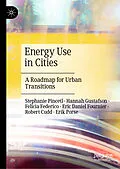"Prof Pincetl and colleagues have compiled a valuable and insightful study on constructing the Southern California Energy Atlas, a unique and world leading resource. This book is informative, instructive, and an essential guide to those seeking to build a knowledge base upon which to take actions supporting the transition of the built environment towards becoming zero-carbon, energy efficient, and resilient."
- Ian Hamilton, Associate Professor,UCL Energy Institute,London
In an era of big data and smart cities, this book is an innovative and creative contribution to our understanding of urban energy use. Societies need energy data in order to understand energy flows and plan for a more sustainable future. However, this data is often either not utilized or not available. Using California as an example, the book describes how to construct a energy data hub for sophisticated, socially-conscious research, and how it may be used to assist local governments and community based organizations to meet their sustainability goals. This methodology maps highly-detailed building energy use to understand patterns of consumption across buildings, neighborhoods, and socioeconomic divisions. The book then details the steps required to replicate this methodology elsewhere, demonstrating the importance of openly-accessible building energy data for transitioning cities to meet the climate planning goals of the twenty-first century. It also explains why actual data, not modeled or sampled data, is critical for accurate analysis and insights. Finally, it acknowledges the complex institutional context for this work and some of the obstacles the project has faced - utility reluctance, public agency oversight, funding and path dependencies.This book will be of great value to scholars across the environmental sectors - especially to those studying sustainable urban energy - as well as to practitioners and policy makers in these areas.
Stephanie Pincetl is Director of the California Center for Sustainable Communities at the Institute of the Environment and Sustainability, University of California, Los Angeles, USA.She works on complex urban systems and their socio-environmental impacts with an aim to provide actionable science for a just energy transition.
Autorentext
Stephanie Pincetl is Director of the California Center for Sustainable Communities at the Institute of the Environment, UCLA. She works on complex urban systems and their socio-environmental impacts with an aim to provide actionable science for a just energy transition.
Zusammenfassung
In an era of big data and smart cities, this book is an innovative and creative contribution to our understanding of urban energy use. Societies have basic data needs to develop an understanding of energy flows for planning energy sustainability. However, this data is often either not utilized or not available. Using California as an example, the book provides a roadmap for using data to reduce urban greenhouse gas emissions by targeting programs and initiatives that will successfully and parsimoniously improve building performance while taking into account issues of energy affordability. This first of its kind methodology maps high-detail building energy use to understand patterns of consumption across buildings, neighborhoods, and socioeconomic divisions in megacities. The book then details the steps required to replicate this methodology elsewhere, and shows the importance of openly-accessible building energy data for transitioning cities to meet the climate planning goals of the twenty-first century. It also explains why actual data, not modeled or sampled, is critical for accurate analysis and insights. Finally, it acknowledges the complex institutional context for this work and some of the obstacles utility reluctance, public agency oversight, funding and path dependencies. This book will be of great value to scholars across the environmental sectors, but especially to those studying sustainable urban energy as well as practitioners and policy makers in these areas.
Inhalt
Chapter 1: Introduction.- Chapter 2: The Larger Context, Cities, Smart and Big Data.- Chapter 3: Building Energy Data Access and Aggregation Rules. Chapter 4: Building an Energy Atlas.- Chapter 5:User Design and Functionality.- Chapter 6: Data Analytics.- Chapter 7: Case Studies.- Chapter 8: Conclusion.
